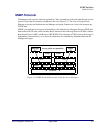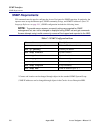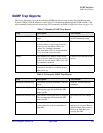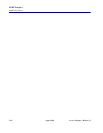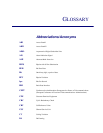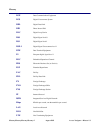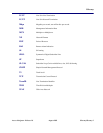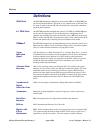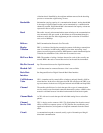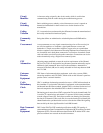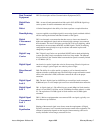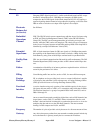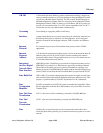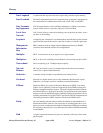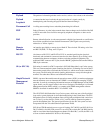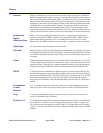violations that is identified by the recipient and then removed in the decoding
process to recreate the original string of zeros.
Bandwidth Information-carrying capacity of a communication channel. Analog bandwidth
is the range of signal frequencies that can be transmitted by a communication
channel or network. Digital bandwidth is the transmission capacity or data rate
expressed in bits or bytes per second.
Baud Bits audio. An early telecommunications term referring to the communications
rate, measured in bits per second, at which data can be transmitted through a
modem or serial data line. Most equipment provide a selection of fixed baud
rates, such as 9600 bps.
Bellcore Bell Communications Research. See Telcordia.
Bipolar
Violation
BPV. A violation of the bipolar transmission pattern, indicating a transmission
error. For example, in AMI coding a BPV occurs when succeeding “ones”
(pluses) are sent at opposite polarities. B8ZS patterns contain intentional bipolar
violations for substitution codes, which are not counted as errors.
Bit Error Rate BER. The number of coding violations detected in a unit of time, usually one
second. BER is the ratio of errored bits received to the total bits transmitted.
Bits Per Second bps. The transmission rate for digital information.
Blocked Call A call that cannot be connected because a line is not available.
Basic Rate
Interface
See Integrated Services Digital Network Basic Rate Interface.
Call Reference
Value
CRV. A number used by central office switches to uniquely identify a DS0 or
subscriber line. In the Access Navigator, the GR-303 switch uses the CRV to set
up crossconnects in the Access Navigator between switch DS0s and drop DS0s.
Channel The smallest subdivision of a circuit that provides a type of communication
service, usually a one-directional connection between two points. A DS0 is often
treated as a channel because it includes both transmission and receive paths.
Channel Bank A CSU with service cards that provide individual analog lines to subscriber
phones.
Channel
Service Unit
CSU. A device used to connect a DS1 (T1) digital phone line from the central
office to a PBX or computer system. A CSU performs line-conditioning and
equalization functions, and responds to loopback commands from the central
office.
Circuit A communications path or network, usually a pair of channels providing bi-
directional communication.



